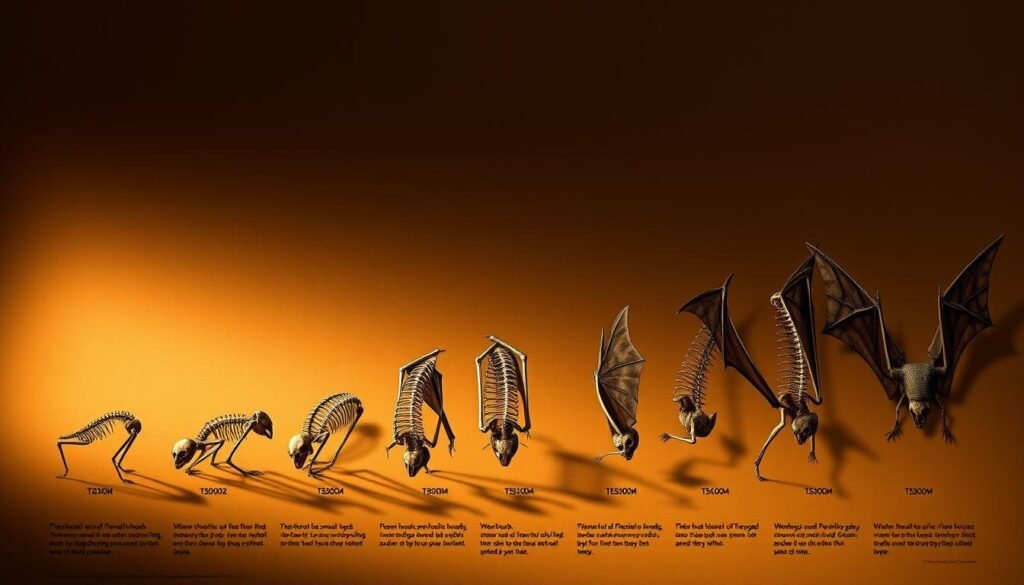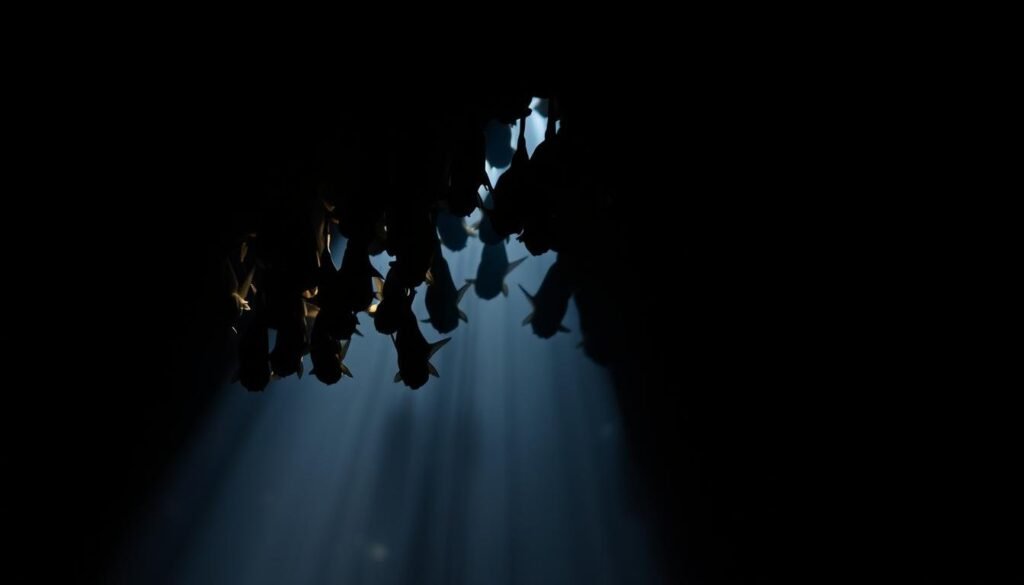Why Do Bats Hang Upside Down When Sleeping? You’ve probably noticed that bats seem to defy gravity by roosting upside down. This unique behavior is a hallmark of their bat behavior, and it’s crucial to their survival.
When it comes to bat sleeping habits, their upside-down roosting is both fascinating and essential. By hanging upside down, bats conserve energy and quickly respond to potential threats. This behavior is a testament to their remarkable adaptability.
As you explore the world of bats, you’ll discover that their upside-down roosting is just one aspect of their intriguing behavior. Understanding their habits can provide valuable insights into these creatures.
Contents
- 1 The Fascinating World of Bats
- 2 Why Do Bats Hang Upside Down When Sleeping?
- 3 Anatomical Adaptations for Hanging
- 4 Evolutionary Advantages of Upside-Down Sleeping
- 5 Bat Roosting Habitats and Preferences
- 6 Other Fascinating Bat Sleeping Behaviors
- 7 Conclusion: Why Do Bats Hang Upside Down When Sleeping?
- 8 FAQ
- 8.1 Why do bats hang upside down when they sleep?
- 8.2 What anatomical adaptations enable bats to hang upside down?
- 8.3 How do bats avoid getting too much blood in their brains when hanging upside down?
- 8.4 What are the evolutionary advantages of upside-down sleeping in bats?
- 8.5 What types of habitats do bats prefer for roosting?
- 8.6 How do bats survive during the winter months?
- 8.7 What is the significance of bat conservation efforts?
- 8.8 How do mother bats care for their pups during rest?
The Fascinating World of Bats
Exploring the world of bats reveals their unique traits and interesting behaviors. They are the only mammals that can truly fly.
The Only True Flying Mammals
Bats can fly thanks to their flexible wings. These are actually modified forelimbs. This special feature lets them move and hunt in the air with great skill.
Global Presence and Species Variety
There are over 1,300 bat species worldwide. They live on every continent except Antarctica. They thrive in many environments, from deserts to rainforests.
Some bats are key pollinators and seed dispersers, especially in tropical and desert areas. They help many plants reproduce.
Insect Control and Ecosystem Balance
Bats are vital in controlling insect numbers. One bat can eat up to 1,200 mosquitoes in just an hour. This helps keep ecosystems balanced and cuts down on pesticide use.
Why Do Bats Hang Upside Down When Sleeping?
Bats hanging upside down when they sleep is not just odd; it’s a survival trick. This behavior is seen in almost all bat species. It shows how well it has helped them survive.
Gravity’s Role in Bat Roosting
Gravity is key in bat roosting. Hanging upside down, gravity keeps them in place without using much energy. This lets bats rest safely without moving much.
Weight Distribution Advantages
Hanging upside down helps bats spread their weight right. This posture lets them relax their muscles while keeping a firm grip. Special tendons and muscles in their feet make this possible.
By hanging upside down, bats save energy. This posture means they don’t need to keep their muscles active all the time. So, they can rest efficiently and survive on less energy.
Thermoregulation While Hanging
Hanging upside down also helps bats stay warm. When they cluster together, it keeps their body temperature steady. This is especially important in cold weather.
| Advantage | Description |
|---|---|
| Gravity’s Assistance | Gravity helps bats remain in place without expending energy. |
| Weight Distribution | Minimizes strain on limbs, allowing for muscle relaxation. |
| Metabolic Efficiency | Reduces the need for constant muscle activity, conserving energy. |
| Thermoregulation | Aids in maintaining a stable body temperature, especially when clustering. |
Understanding these points shows why bats sleep hanging upside down. It’s a clever adaptation that boosts their chances of survival.
Anatomical Adaptations for Hanging
Bats can hang upside down thanks to special features. These traits help them roost easily in their favorite position.
Their claws are a key adaptation. Made of keratin, these strong, curved claws grip surfaces well. This lets bats hang securely.
Reversed Knee Joints
Bats have unique knee joints compared to other mammals. This feature lets them hang comfortably upside down. It helps their legs bend in a way that holds onto branches or roosting sites firmly.
How Passive Gripping Works
Bats can grip passively when hanging upside down. This means they can lock their claws in place without much effort. Their muscles relax, keeping the grip strong, so they can rest or sleep safely.
Blood Circulation Adaptations
Bats also have special blood circulation to protect their brains. Hanging upside down could cause too much blood flow to the brain. But bats have evolved to control their blood pressure and flow. This ensures their brains get the right amount of blood.
These adaptations together allow bats to hang upside down effortlessly. It shows their amazing ability to adapt physiologically.
Evolutionary Advantages of Upside-Down Sleeping
Exploring bats reveals their upside-down sleep is key to their success. This behavior gives them survival boosts and helps their numbers grow.
Hiding from Ground Predators
Bats sleep upside-down to avoid ground predators. Hanging from ceilings or branches keeps them safe from most ground predators.
Camouflage in High Places
Bats hide in high spots like caves or tree cavities. Their upside-down pose and dull colors help them blend in, making them hard to spot.

When danger comes, bats can drop and fly away fast. This quick move helps them escape predators and stay safe.
Survival Rates Compared to Other Roosting Methods
Research shows bats’ upside-down sleep boosts their survival. Their ability to avoid predators, hide, and quickly fly away makes them successful.
- Predator avoidance is a key factor in bats’ survival.
- Camouflage in elevated roosts enhances their protection.
- The “drop and fly” technique allows for quick escapes.
- Higher survival rates are linked to their unique roosting behavior.
In summary, upside-down sleeping is a big advantage for bats. It helps them survive and thrive. Learning about this behavior shows how adaptable bats are.
Bat Roosting Habitats and Preferences
Bats roost in many places, from dark caves to tree foliage. They are very adaptable, using different environments for their roosts.
Caves and Rock Crevices
Caves and rock crevices are common roosting sites for bats. They offer protection from predators and harsh weather. This makes them a stable place for bats to rest and socialize.
Trees and Foliage Roosts
Some bats roost in trees, in the foliage or under the bark. These roosts are often temporary. They might change them to avoid predators or follow food.
Bats also roost in human-made structures like attics, barns, and under bridges. These places offer protection similar to natural roosts. They are warm and secluded, making them attractive to bats.
Bat Houses and Conservation Efforts
Conservation efforts include installing bat houses. These artificial roosts mimic natural conditions. They provide bats with safe places to roost and breed, helping with bat conservation.
Other Fascinating Bat Sleeping Behaviors
Bats have amazing sleeping habits that are as interesting as their flying skills. They have special ways to survive and grow in different places. Their sleep patterns are key to this.
Winter Survival Strategies
Bats have clever ways to make it through the cold winter. One way is bat hibernation. In hibernation, they slow down their energy use. This lets them live off stored fat.
- Reduced activity levels
- Lowered body temperature
- Slowed heart rate
Metabolic Changes During Hibernation
In bat hibernation, bats change a lot. Their heart rate gets much slower. Their body temperature also drops to save energy.
Colony Formation and Benefits
Bats often live in groups, called colonies. These groups help by sharing warmth and protecting from predators. Colony formation is very important for bats, especially when they rest or hibernate.
The bond between mother bats and their pups is very strong. Mother bats keep their pups close for safety and warmth. This mother-pup relationship is crucial for the young bats’ survival.
In conclusion, bats’ sleep habits are complex and varied. They involve survival strategies, social bonds, and adapting to their surroundings.
Conclusion: Why Do Bats Hang Upside Down When Sleeping?
You now know why bats sleep upside down. It’s because of their special body parts and how they evolved. This helps them survive and is key to their role in nature.
Bat sleeping habits are not only interesting but also crucial for the environment. They roost in different places, like caves and trees. Their choice of where to sleep is important for their survival.
It’s important to protect bats and their homes. Learning about bats helps us see why we need to save their habitats. You can help by supporting groups that work to save natural places and teach people about nature.
Thinking about bats shows us how important they are to our planet. By helping to save them and learning about their biology, we can make sure they continue to thrive.
See Also: Koalas Sleep Up to 22 Hours a Day – Here’s Why
FAQ
Why do bats hang upside down when they sleep?
Bats sleep upside down to save energy and keep their body temperature right. It also lets them fly fast if they need to.
What anatomical adaptations enable bats to hang upside down?
Bats have special claws and knees that work in reverse. They also have a way to grip without using much energy.
How do bats avoid getting too much blood in their brains when hanging upside down?
Bats have special blood flow that keeps their brains safe. This way, they can sleep upside down without worry.
What are the evolutionary advantages of upside-down sleeping in bats?
Sleeping upside down helps bats stay safe from predators. It also helps them blend in and fly away quickly. This makes them more likely to survive.
What types of habitats do bats prefer for roosting?
Bats like different places to roost, like caves, trees, and even attics. It depends on the type of bat.
How do bats survive during the winter months?
In winter, bats hibernate to save energy. They also snuggle up together to stay warm.
What is the significance of bat conservation efforts?
Saving bats is key to keeping our ecosystems healthy. Efforts like bat houses help protect these important animals.
How do mother bats care for their pups during rest?
Mother bats keep their pups warm and safe. They also teach them how to survive.

Zyair Larson, based in Denver, Colorado, has over 12 years of experience studying animal behavior. He has worked with the World Wildlife Fund (WWF) and National Geographic, researching wildlife and sharing insights on animal habits globally.

